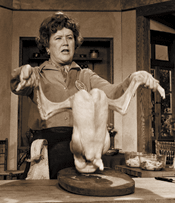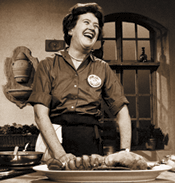A 3- to 4-ounce chunk of lean bacon
A heavy, 10-inch, fireproof casserole
2 Tb butter
2 1/2 to 3 lbs. cut-up frying chicken
1/2 tsp salt
1/8 tsp pepper
1/4 cup cognac
3 cups young, full-bodied red wine such as Burgundy, Beaujolais, Côtes du Rhône, or Chianti
1 to 2 cups brown chicken stock, brown stock or canned beef bouillon
1/2 Tb tomato paste
2 cloves mashed garlic
1/4 tsp thyme
1 bay leaf
12 to 24 brown-braised onions
1/2 lb. Sautéed mushrooms
Salt and pepper
3 Tb flour
2 Tb softened butter
A saucer
A rubber spatula
A wire whip
Sprigs of fresh parsley
For 4 to 6 people
|
 Coq au Vin Coq au Vin
(Chicken in Red Wine with Onions, Mushrooms, and Bacon)
This popular dish may be called coq au Chambertin, coq au Riesling, or coq au whatever wine you use for its cooking. It is made with either white or red wine, but the red is more characteristic. In France it is usually accompanied only by parsley potatoes; buttered green peas could be included if you wish a green vegetable. Serve with it a young, full-bodied red Burgundy, Beaujolais, or Cotes du Rhone.
Remove the rind and cut the bacon into lardoons (rectangles 1/4 inch across and 1 inch long). Simmer for 10 minutes in 2 quarts of water. Rinse in cold water. Dry.
Sauté the bacon slowly in hot butter until it is very lightly browned. Remove to a side dish.
Dry the chicken thoroughly. Brown it in the hot fat in the casserole.
Season the chicken. Return the bacon to the casserole with the chicken. Cover and cook slowly for 10 minutes, turning the chicken once.
Uncover, and pour in the cognac. Averting your face, ignite the cognac with a lighted match. Shake the casserole back and forth for several seconds until the flames subside.
Pour the wine into the casserole. Add just enough stock or bouillon to cover the chicken. Stir in the tomato paste, garlic, and herbs. Bring to the simmer. Cover and simmer slowly for 25 to 30 minutes, or until the chicken is tender and its juices run a clear yellow when the meat is pricked with a fork. Remove the chicken to a side dish.
While the chicken is cooking, prepare the onions and mushrooms (see recipes below).
Simmer the chicken cooking liquid in the casserole for a minute or two, skimming off fat. Then raise heat and boil rapidly, reducing the liquid to about 2 1/4 cups. Correct seasoning. Remove from heat, and discard bay leaf.
Blend the butter and flour together in a smooth paste (beurre manie). Beat the paste into the hot liquid with a wire whip. Bring to the simmer, stirring, and simmer for a minute or two. The sauce should be thick enough to coat a spoon lightly.
Arrange the chicken in the casserole, place the mushrooms and onions around it, and baste with the sauce. (*) If the dish is not to be served immediately, film the top with stock or dot with small pieces of butter. It can now wait indefinitely. Shortly before serving, bring to the simmer, basting the chicken with the sauce. Cover and simmer slowly for 4 to 5 minutes, until the chicken is hot through.
Serve from the casserole or arrange on a hot platter. Decorate with sprigs of parsley.
|


 Last week, America lost a national treasure—and Knopf lost a beloved author. Julia Child made the art of French cooking accessible, transforming the way America cooks. In this newsletter, we offer you a recipe for the classic Coq au Vin, from Julia's landmark first book, Mastering the Art of French Cooking. Plus, below you will find an essay from Julia's lifelong editor and friend, Judith Jones, and links to a variety of Julia tributes from national publications.
Last week, America lost a national treasure—and Knopf lost a beloved author. Julia Child made the art of French cooking accessible, transforming the way America cooks. In this newsletter, we offer you a recipe for the classic Coq au Vin, from Julia's landmark first book, Mastering the Art of French Cooking. Plus, below you will find an essay from Julia's lifelong editor and friend, Judith Jones, and links to a variety of Julia tributes from national publications.
 Fondly,
Fondly,